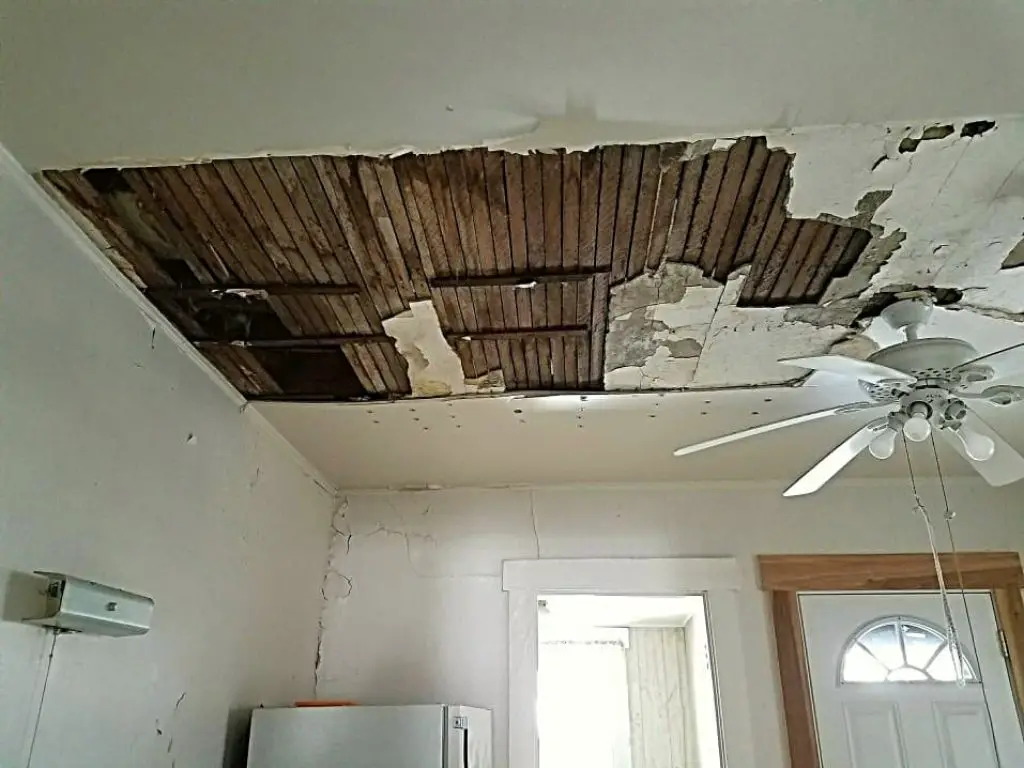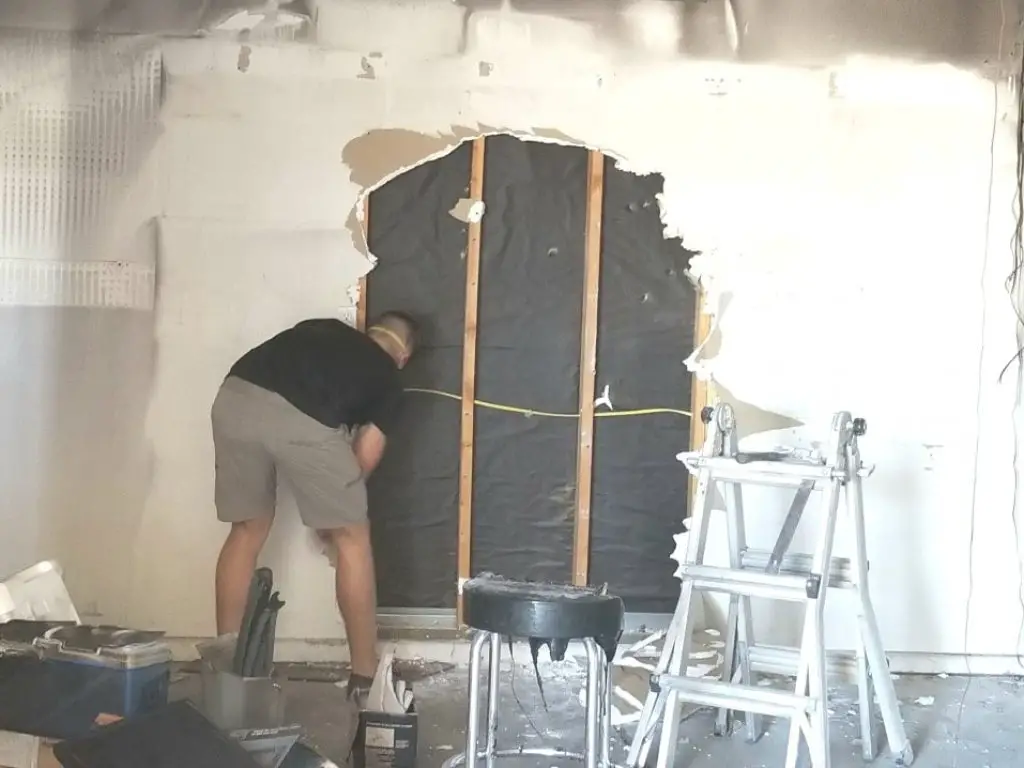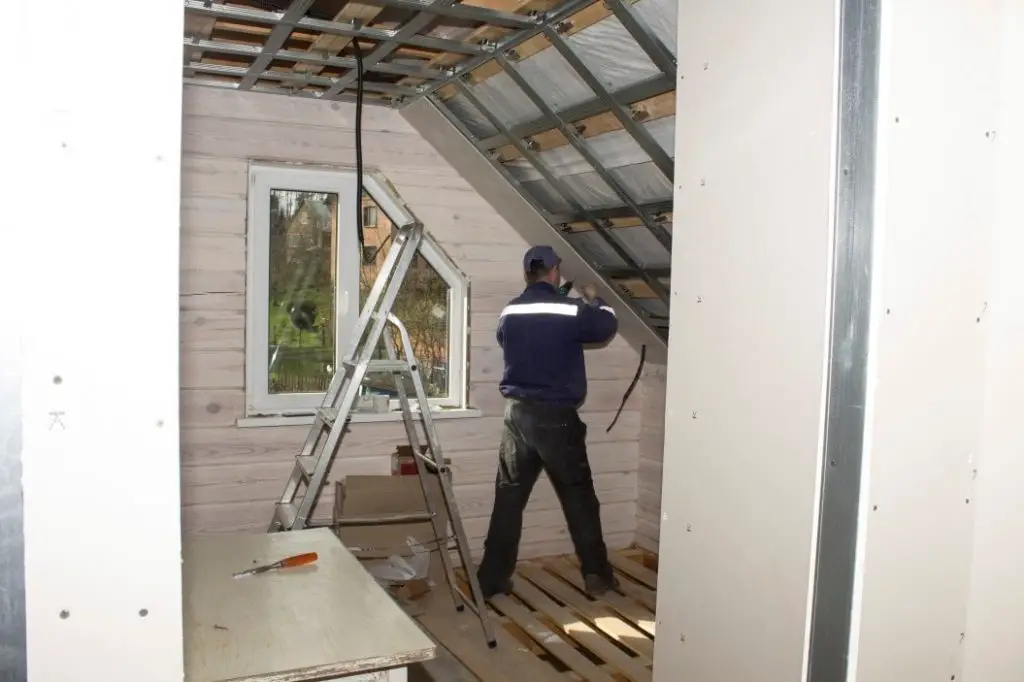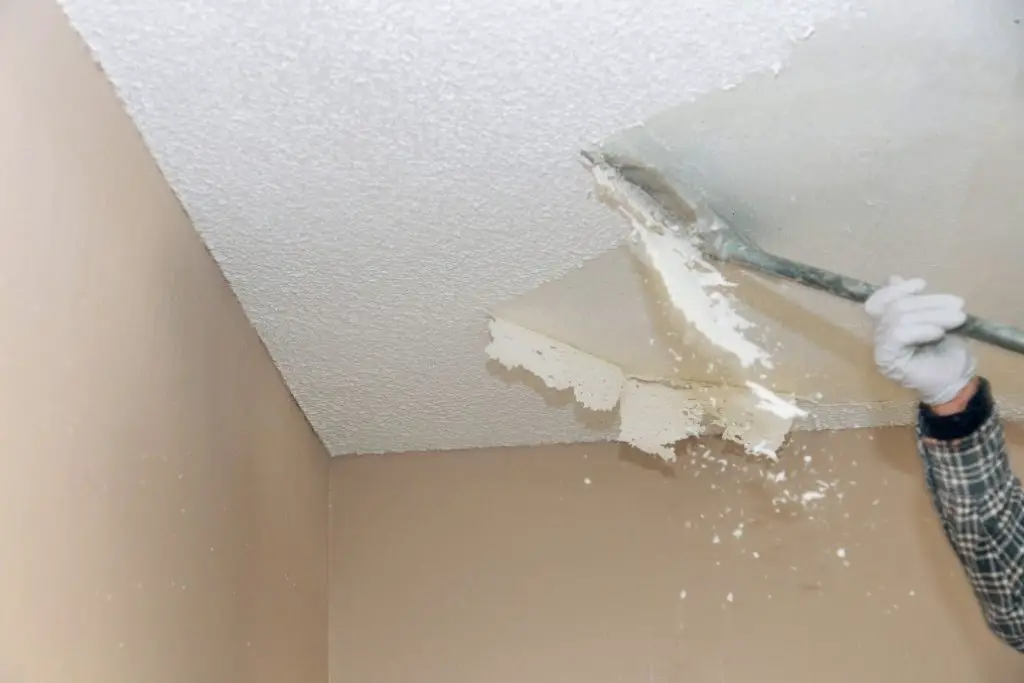Did you know that reportedly 400,000 people in the United States die every year due to lead poisoning?
Alarming, isn’t it?
What makes it even worse is that lead exposure can affect people of all ages, and children are the most vulnerable to it. Their still developing bodies make it easy to cause health problems, and at the same time making it hard for them to fight these illnesses on their own. That is why childhood lead poisoning is prevalent.
It is present in so many places, but the biggest known culprit of exposure to it is lead-based paint. Now, the question that a lot of people ask themselves is “is there lead in the drywall of an old house?”.
Chances are that there is lead in the drywall of your home if it was built before 1978, and in this article we’ll teach you how to test for it, and what you should be doing, as well as the signs to look for on your walls.

In the past, high levels of it were mixed in because of its benefits. But when people started getting sick and even died because of the exposure to the heavy metal, they pushed to eliminate its use.
Unfortunately, many old homes in the US are likely to still have the dangerous substance in them. As a result, anyone that lives in such a home is in danger of experiencing the many hazards associated with it.
Its presence should always be taken seriously. If you are not aware of the health risks, keep reading because you will understand why exposure is so dangerous that it resulted in a ban.
You will also learn how to check for lead in the paint used in an old home, as well as what you need to do if it is present.
Dangers
Touching a lead-based paint that is in good condition and with no signs of damage or deterioration will hardly pose any health hazard. It is only the damaged or chipping parts that you need to worry about. This creates dust that will put anyone at risk of experiencing its dangers.
It is not the paint itself that we need to worry about. Rather, the dust generated that is what we should be wary of. Since the dust is invisible, we will never know when we start getting exposed to it.
According to the US Department of Health and Human Services, exposure to it can happen in three ways:
- Inhalation – hard to determine because lead does not have a scent
- Ingestion – dust can settle on your food and drinks, or you may transfer it to your mouth through unwashed hands. It may sometimes have a metallic taste, which can serve as an indicator.
- Skin Contact – dust can also be absorbed through the skin and enter the bloodstream.
Unfortunately, there are no early signs or symptoms that will indicate once someone has been exposed to lead in small doses. We will only know if we have fallen victim to it once the amount present in our bodies is high enough to cause various health issues.
Children are at greater risk of experiencing health complications due to lead because their absorption of this metal is reportedly 4 to 5 times that of adults. This is due to their natural curiosity to touch stuff and immediately put anything they can get their hands on into their mouth, including objects that have it in them.

These signs and symptoms can be age-specific and may also be signs of other possible illnesses, that is why it is challenging to attribute them to lead poisoning alone:
For Newborns Who Got Exposed Before Birth
- Birth weight is lower
- Born prematurely
- Slow growth
Children
- Lethargy
- Mental retardation and developmental delays
- Reduced IQ
- Behavioral issues, such as antisocial behavior, pica or the eating disorder where non-food items are eaten, and low attention span
- Loss of appetite
- Nausea
- Vomiting
- Constipation
- Convulsions
- Weight loss
- Hearing issues
- Irritability
- Abdominal pain
- Anemia
- Impaired functions of the neurological and nervous systems
- Hypertension
- Kidney issues
- Immunotoxicity
- Encephalopathy
- Stunted growth
- Gums having a blue tinge
Adults
- Muscle and joint pain or weakness
- Elevated blood pressure
- Headache
- Mood disorders
- Difficulty concentrating or memory loss
- Abnormal sperm or poor sperm quality
- Reduced sperm count
- Cramps and abdominal pain
- Motor issues
- Fatigue
- Lack of appetite
- Numbness or tingling sensation in the extremities
- Constipation and black diarrhea
- Aggressiveness
- Sleeping issues
- Hallucinations
- Miscarriage or premature birth for pregnant women
- Low fertility
- Carpal tunnel syndrome
- Ankle or foot drop
- Gout
- Going into a comatose state
- Damage to the brain (reduced brain volume)
- Digestion issues
- Loss of libido
- Metallic taste in mouth
Treatment is still possible but leaving it too late can cause irreversible damage. Too much exposure to lead will cause poisoning that can result in death if left untreated.
Why Was It Added?
Given all the health hazards, you might wonder why it added to paint in the first place. All the risks aside, it is an extremely helpful substance for a lot of purposes. This is also the reason why it is still present in some places despite bans present all over the world.
In the past, it was added primarily to give it their desired color; different pigments were added to produce different colors and give it a brighter and fresher look. These pigments also have greater opacity, allowing the paints they were mixed in to have a bigger coverage than other options.
Paint takes time to dry and adding lead will speed up this part, that is why pros use it as an additive. Its flexibility also allows it to be crack-resistant even in harsh conditions, which cannot be said for other products in the past. Also, it provides moisture resistance that prevents corrosion on the surfaces where it is applied on.

It is also known to be durable, holding up to wear and tear well, and is also capable of preventing the growth of mold and mildew. These features are ideal for home use, that is why it became a household favorite for so long.
However, this does not mean people chose to ignore the harmful effects. Rather, they were still unaware of the hazards back then and were more focused on the benefits that it provided.
| Information on lead paint | Note |
| When was it banned | 1978 |
| Products to test for it | 3M LeadCheck |
| Long-term exposure | Headaches, muscle pain, irritability, & cognitive decline |
| Cost to remove it. | $10,000 – $30,000 |
When Did They Stop Using It?
Tracing back its history, we can see that this element was widely used for centuries. In fact, ancient Egyptians were discovered to have used a lot of lead, from their signature eye makeup to paints. The US is no exception, owing to the fact that a large percentage of homes for decades made use of this dangerous substance.
So, when did they stop using it?
In the US, it was only in 1978 when lead-based paint was completely banned for residential use, despite knowing about the possible health risks long before then. Sadly, health advocates and legislators had to fight the industry bigwigs for decades until a complete ban could be put in place.
But when it comes to industrial use, it is still pretty much in use. Its anti-corrosive property is a much-needed aspect for bridges and other steel structures where durability is vital. Current legislations in the US only allow its use on such structures, as well as for shipbuilding and its repair, farming equipment, and for signs on the road itself.
The worldwide use is a different story. Many developing countries still sell it because it ends up cheaper than alternative options, as a gallon of it has more coverage than a gallon without. Most of these countries are also unaware yet of the health hazards associated with exposure.
Only a few countries worldwide have completely regulated the use for both residential and industrial purposes. That is why many homes built after 1978, even in the US, may have lead-based paint present, though the number of such homes are steadily declining.
Do All Homes Built Before 1978 Have It?
Since the US ban was only imposed a few decades ago, you may be wondering if all homes that were built before 1978 made use of it.
The good news is, not all of those homes built before that year made use of it But the bad news is, a vast majority of them did. The US Environmental Protection Agency, or EPA, published a report that stated:
- 87% of homes built before 1940 is likely to have it
- 69% of homes built between 1940 to 1959 is likely to have it
- 24% of homes built between 1960 to 1977 is likely to have it
Despite the ban in place since 1978, more than a million homes in the US are suspected to have used lead-based paint.
How Do You Know If There Is Lead in Your House – How to Test for it
It is a given that old homes are more likely to have used lead-based paint. If your home was constructed on or before 1978, chances are your home fits that bill. Still, there is a slim chance that you are one of the few fortunate homeowners who have a safe home.
If you are planning on doing home renovation soon, you need to know for sure if you are at risk of health issues with improper remodeling practices. This begs the question: how do you know if it is in your house?
Unfortunately, you cannot detect or check for it in your home by simply looking at it. However, you may suspect its presence if you see chipped or cracked parts in a geometric pattern reminiscent of scales, or the residue present on the damaged parts appear chalky.
Confirming if lead is present in your home is done by a professional inspection and thorough testing.
Fortunately, you do not have to immediately get your home inspected or tested if it was built earlier than 1978 if your home is still in pristine condition. Like we mentioned, it is not dangerous if it is in perfect condition and shows zero signs of damage.

But if you meet the following conditions, it is a good idea to check if it is present in your home, even if you have no plans of getting it renovated anytime soon:
- You live with children in an old home constructed on or before 1978, as they are most susceptible to exposure, and they play in the surrounding soil
- Your home has never been renovated
- Your home is in poor condition and has affected the paint (peeling, cracks, flaking off, etc.)
If you want to know how to test for lead, there are three ways of doing so:
- Hazard screen – best for homes with a minimal risk. Testing is done by first checking which parts of your home have signs of damage or deterioration. Dust from the floors and windows of those areas is then collected for testing. These two sets of dust are then tested for the presence of lead.
This test will only determine if your home is at risk for the possibility of lead-based paint being present, but will not serve as a confirmation for its presence.
- Risk assessment – any damaged surface in your home is checked and the cause of deterioration is identified. The damaged part, as well as any surface that may have been touched, bitten on, or licked by children, is tested for the presence of lead. Testing is also done on the soil near the foundation of your home and on play spaces, as lead dust may be present on those locations.
Only the paint that looks untouched is not checked.
- Inspection – all surfaces of your home that have been painted, outside and inside and even behind wallpaper, will be checked. This can be done while onsite or by collecting samples that will be sent to an EPA-accredited laboratory.
This type of inspection will confirm the presence in the paint, but not the amount present nor any potential health hazards.
Contrary to what most people think, lead-based paint is not only used in the walls of a home. Other likely spots where the paint is used, or where its dust can settle in your home include:
- Doors and doorframes
- Windows and windowsills
- Floors below windows
- Porches
- Playground
- Artificial turf
- Furniture
- Woodwork
- Stairs
So if the walls seem to have no lead present but other parts or sections of your home have paint that is as old as your home or buried underneath newer layers of non-lead-based paint, you should still get those structures checked too.
| Ways to test | Our comments |
| D-Lead | Our preferred non-reusable test |
| 3M | Another disposable kit |
| XRF | Doesn’t leave marks when used. You need a pro to come out with the device. |
Can I Test The Drywall Myself?
With all the hazards associated with it and how costly it is to get an old house professionally tested for its presence, a common question that homeowners ask themselves is, “can I test for lead paint myself?”
While most would advocate for getting it done professionally, you can still do the drywall lead paint testing yourself with products available from 3M that are widely available on the market. These kits consist of chemicals or swabs that change color when they come into contact with lead. While it can be done by anyone who can follow instructions, those who are color blind may have difficulty interpreting the results.
These DIY kits cost a fraction of the price of a professional testing, making them a practical option for homeowners who need immediate results and are on a tight budget. Certain kits can also indicate the amount or level of lead present in the tested area.
There are two common kinds of DIY kits available: sulfide-based kits that are best for light colors only and rhodizonate-based kits for all colors, save for pink and red because these colors can give false positives. Also, only a few kits are EPA-certified, so make sure to get such kits for accurate results.
It is also vital that you check their expiration dates before testing, and strictly follow the instructions given. Using expired testing kits or skipping important steps when testing will compromise the results.
But before you start testing for lead, make sure to keep you and your household safe by:
- Keeping everyone, especially children and pregnant women, away from your home, if you suspect that lead dust is present
- Making sure you are well covered up by wearing rubber gloves, face mask with a HEPA filter, lab goggles, and other protective gear
- Testing in an inconspicuous area, such as inside a closet or cabinet, corners, or any location that is left undisturbed
Testing often involves scraping off about a quarter inch of the paint, especially if there are multiple layers present, if there are no signs of flaking that can be used for the test. Make sure to sanitize the area first before doing the actual testing.
Consider buying several tests if you plan to check multiple sections of your home, or even your furniture and children’s toys that are also known to possibly use lead paint, as each kit normally contains enough materials for a maximum of six tests. One kit may not be enough to cover all the structures or objects you want to test. Make sure that the kit you buy in fact is meant for the surface you’re testing, as some products will only cover certain types of material.
If lead is detected, you need to follow the following steps outlined by the EPA:
- Get your home checked by an assessor who is certified by the agency
- Check the report created based on the professional assessment
- Determine if you can retain the paint or abatement is needed, based on the report
It is possible to retain the paint with lead in your home, but the downside to this is that regular inspection and maintenance is a must, and that any home renovation you plan to undertake must only be done by contractors who are lead-safe certified.
But if abatement, whether through complete removal or by getting the lead-based stuff sealed or enclosed, is recommended by the assessor, it must only be done by certified abatement contractors.
You and your household should also undergo a blood test to detect if you have already been exposed to lead and the level present in the bloodstream, and if any medical intervention is needed if it is detected.
Can You Just Paint Over It?
With all the necessary measures needed when dealing with this issue, it is common for homeowners to find shortcuts or inexpensive means to solve the problem. For many, they think of just covering it up with a new layer of non-lead-based paint, believing that this new layer will keep the lead present in place. Not only is this easy but it is also cheaper than hiring pros to do the needed fixes.
While this method is doable, and even recommended in some cases, you also need to remember that this is a temporary solution and will depend on how long the upper coat will hold up over time.
Take note of the following if you are planning to cover up the lead-based paint with new coat:
- The paint with lead and the surface that will be painted on is still in good condition and has no signs of damage that can produce dangerous dust
- It is done only in locations where the painted surface will be left undisturbed or exposed to minimal traffic that will not subject it to wear and tear
- A special sealant known as an encapsulant must be used to prevent the lead ‘from chipping or creating dust. Note that encapsulants are different from other ‘options and come in three types: polyurethane polymers or epoxy, polymers, and cement-like encapsulants.
- Aside from encapsulation, you can also use an enclosure, such as a drywall or cladding, to cover up dangerous surfaces. But if you remove those enclosures, you will again expose the problem area. Yes, that means that you can in fact put drywall over lead paint, as a means of enclosure, but if the area gets affected during the installation, you will want to take precautions to stay safe.
Note that any surface with lead paint that frequently gets touched or walked on should never just have a new coat applied to it. Friction can cause the new coat and encapsulant to wear off over time, exposing the area. And you will have to go over the process once more.
This cycle will just repeat if you paint over a lead paint-covered surface that can easily succumb to wear and tear. That is why for such surfaces, safe removal methods done by pros should be done.
How to Remove It
First of all – we strongly discourage any homeowner from attempting to do this themselves!
With all the health hazards involved, you may want to think of going for a more permanent solution when it comes to dealing with this issue in your home, especially if you have very curious children who love to run around and taste whatever they can get their hands on.
If you want to get rid of these health risks for good, the best way to do it is to remove all the existing paint in your home and use non-lead-based paint instead.
Unfortunately, this is easier said than done. Removing it is not as easy as removing ordinary stuff, as the dust generated from stripping the paint is the most dangerous. That is why the removal should be as less invasive as possible to avoid creating such dust, and that safety precautions are always in place.
Some safety measures needed before, during, and after starting this task include:
- Test the surface using only an EPA-approved kit, like those from 3M.
- Completely sealing off all openings and use polyethylene sheeting on doorways to minimize the spread of the dust
- Shutting down the HVAC system to prevent any dust from getting to other parts of your home
- Covering up the flooring with plastic
- Transferring all your belongings elsewhere or covering them up with sheets of plastic to avoid being contaminated by the dust
- Preventing everyone except contractors from entering the house while work is ongoing
- Making sure that anyone working on paint removal is completely covered up by wearing long sleeved shirts, long pants, goggles, gloves, and a half-face respirator mask with HEPA filter
- Washing or disposing clothes that were used during the removal separately
Safely removing this paint is done by pros using any of these methods:
- Wet scraping – water is sprayed over the area every now and then to prevent dust from forming while it is being scraped off by hand.
- Wet hand sanding – similar to paint removal by wet scraping but instead of a hand scraper, sandpaper or a vacuum that has a HEPA filter is used
- Dry power sanding – a sander with a dust shroud is attached to a HEPA vacuum and is used on the painted surface. However, there no need to spray water over the paint while it is being removed because the dust shroud will immediately collect all the dust produced when sanding
- Low temperature or steam heat – heat coming from a steam gun or infrared paint strippers is used to soften the paint for easy removal. While this method does not create dust, it does produce harmful fumes
- Chemical strippers – only the paint itself is affected by the chemical, which makes it a less invasive method. This is best suited for removing paint on surfaces of historical or heritage structures, as well as boats and ships
After getting the paint removed, its disposal is not as simple as sweeping the debris up with a broom and dustpan, then throwing it to the nearest garbage can. Collecting the debris is done using a HEPA filter vacuum and using damp sponges and mops to wipe up all the floors, ceilings, and walls to make sure all the dust generated is removed. The debris must also be discarded properly and to the proper facilities.
Another method is to completely replace all parts of your home that has lead paint. This may be ideal if it is only used on limited surfaces, such as doors, but you may as well get your entire home demolished if such paint is found all over your home.
When it comes to dealing with the possibility of lead-based paint, we should always err on the side of caution. Always prioritize safety over saving a few dollars by not confirming its presence.




